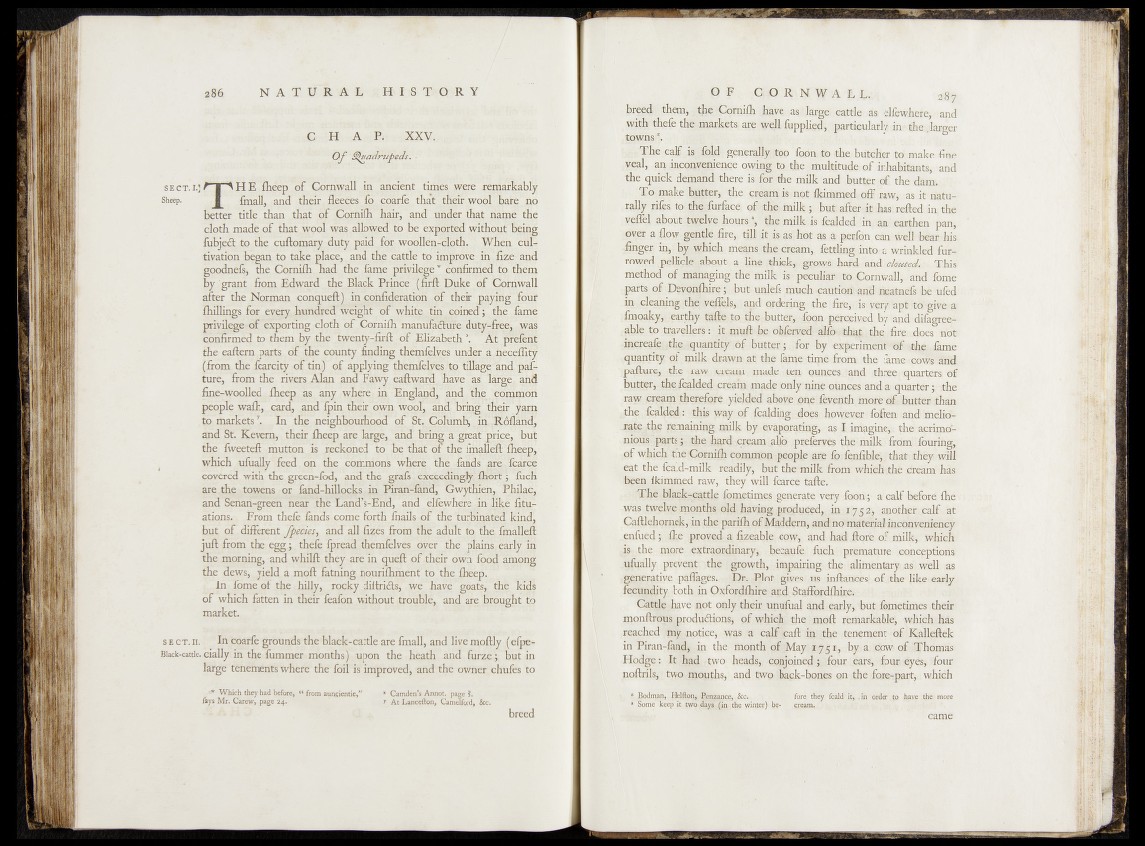
286 N A T U R A L H I S T O R Y
C H A P. XXV. ,
O f Quadrupeds. ■
sect.i.j A | AHEf fheep o f Cornwall in ancient times were!rfariar|abry
Sheep. I fmallj and their fleeces Ip coarfe that Their wool bare np
better title than that 6f Comifli hair, and under that; name the
cloth made of that wool was allowed to be exported without being
fiibjerit tp tfie cuftomary duty paid for woollen-cloth. When cul-r
tivation began to take place, and the cattle to improve in fizje'^apd
goodnels, the Cornifh had the lame prxyilege ’' confirmed to. them
by 'grant from Edward the Black Prince (firft Dyke of Cornwall
after the Norman conqueft) in conlideration .of their payjhg^fquf
Shillings for every. hundred weight Or whjtqJtin coined ; me I&gie
privilege of-exporting cloth o f Cornifh manufacture duty-free, .was
confirmed to them by the twenty^hft -of -filnz^eth *. ^ t ]^re^|
the eaftem parts o f the county finding
(from the jfcarcity oftin) of applying themfelves to tillage and pasture,
from the rivers Alan and ^psy eaftward have as large ?n4
fine-woolled iheep as any where. in England, and the edmmori
people wa£h, card, and Ipin their own wool, ana, firing mdTr yarn
to marketsr. In the neighbourhood o f ifi
and St. Kevem, their fheep are large, ahd-brmg^ a^ e a tr tr ic^ ^dt
the Iweeteft mutton is reckoned to be that of the fmajjlefl:"Iheep,
which ulually feed on the commons where' the fands are fcarce
covered with the green-fed, and the gtttis exceedingly fhort; men
are the towens or land-hillocks in Piran-land, Gwythien, Philac,
and Senan-green near the Land’s-fsnd, aria elfewhere .in .like Ijtu-
ations. Prom thefe lands come forth lhails o f the turoinated kind,
but o f different fpecies., and all figes from the adult to the Imallefl:
juft from the egg ; . thefe fpread themfelves over the plains early in
the morning, and whilft they are in quefl of their own food among
the dews, yield a molt fatning nourifliirient to the fheep.
In lome of the hilly, rocky diftridts, we have goats," the kids
of which fatten in their feafbn without trouble, and are brought to
market.
s e c t. ii. In coarfe grounds the black-cattle are fmall, and live moftly (elpe-
Biack-catde. cially in the fummer months) upon the heath and furze; but in
large tenements where the foil is improved, and the owner chufes to
Which they had before, “ from auncientie,” * Camden’s Annot. page 8.
fays Mr. Carew, page 24. - r At Lancefton, Camelford, See.
breed
■ O F % C O R N W A E L. • 28?
breedlf^em, iffegnifh ^v©oas large, cattle as elfewhere, and
with thefe the markets are well- fupplied, particularly in t&ajaiger
« » T te f epn, the butcher hfaaake. fiae
jS^al, a^pnep^pieage ow i^ fej^e :'mukitudejp.f inhabitants, and
the quick deihffaff there isdllrrthe m'lkfend bytSgr.of the dam.
T o make betters t;he cpe^n^jis’jnpjt fkimmed, off raw,: as.it naturally
rifes, to fih|ffu§facei, ofrjfijejfhfilk | -buJi aftersifi .has .refled in, the
veffel twelve7:hoprs)h' iriilkis fealdedriiiij an' earthen pan,,
,,pvec a^pwgentle ^re,, 4 tt;4f’i s vas;hot as^pj^fen.Qan well bear his
% 1 mq%ns fh&pK&m, fetdfegintpea wrinkled 'fur-*
rowed pellic^bout. a line thick,-, grows, hard and. dwtvdr, This
methdd ofJrifenaging tthe^ttuli' l^peculfar»;%tCoriiwallr ‘ and' feme
parts of ’ Devqp|hire; but tmlefs neatnefe be riled?
in cleaning,ithqw^lfls^.and ordering thp;frig-ifis' verjdapk'tofgivE a
fmQaky,,,'parJ:hy tgffe to the ^utt^jj^on peresmedy a p g l fijfegrr^
rf&fe to travellers:; it muff be obferted- alfo that the .firekjtfoesj ribe*
inpreafe dh?#[uantity\of byttert; for by ex'perimert^fef *6%^ feme
^quantity of ryiilk (fra\yft at' thg farqe tripe, from the fakwrerillland
paffu^&j rthe rtaw i?r^^, m.adie ^ firisetdaW
bwjfc^rj^^iilc^Jded ounces and. ^quarter & the
raw cream therefpre yielded §l»yc qi^ feyepih more A butte® than
^the, leaked: thjs way of lealding .does however fofren aridmelio-
jrate ^ remaining nirilje by Qv^prftiflgj a^ I. imagirie»; th» arrirnnt
nii^rf^rts; t^e preferyes riheirnilk, fi™ :ifouring,
jgf wfrich the Comilp common peopfe are ferj^gSMe||tha6rith^iB8I
eat the fcald-milk’" readily, but the milk from whichithe firearm hds
been lkinuned raw, they will fcafee' tafte.
The black-c^tje foretimes generate; veiy -feori;• a cgdf before, flferi
was twelve -months old having .proffyeed, a ftc 2, .another .calf> 1 at
Caltiehpmefejin the parifh of Maddern, andnomiaterial iriconvenieney
.enfued »U p proved fizeabje cow, and hadffqrb' of> rikilk, which
is .the mqre extraqr^riiary, becaufe luch premature rioncpptioiis
.§feally prcveqtv the f grpwth, impairing the alimp.nfary; as well as
.generative pal^ges. -rDr. aPlot gives us inffsricesi ofjthe Jike early
fecqpdffyfjboth.i11 Oxfordlhire apfi Sfafifirriniire.
Cattle |iave wot q%ly their unyffial and tP^yi.'btit;^n|dtet«:'vtiiefr'
monftrous productions, of which the moft remarkable, vvhichihas
reached iriyjnptice, was a calfgpaft in the tenement of JCallpftek
in Tiran-landj ip t ^ o^ifi'hoai^s'
Hodge: It hadtesv'o^ heads, c^bjoined ;, rTQrir .ears, foup..^y<fs; Tour
noftrils, two tp°pths, and tjwp ’ba.ck-b.Qa.es on .the fore-part, which
* Bpdn^an, Helftohji P^ru^ance, &c.*.«ft\ •* '"V’^ fore they feald itx«& order t{o ihave .tfee«' more
* Some keep it ,^ o dayeJ^.tJie 'winter) fee- .qre.am.
came